Good Dogs
The Education of a Bird Dog
For Ramin Jackson, training a gundog doesn’t start with shouting and shock collars. It starts with getting to know his pupil
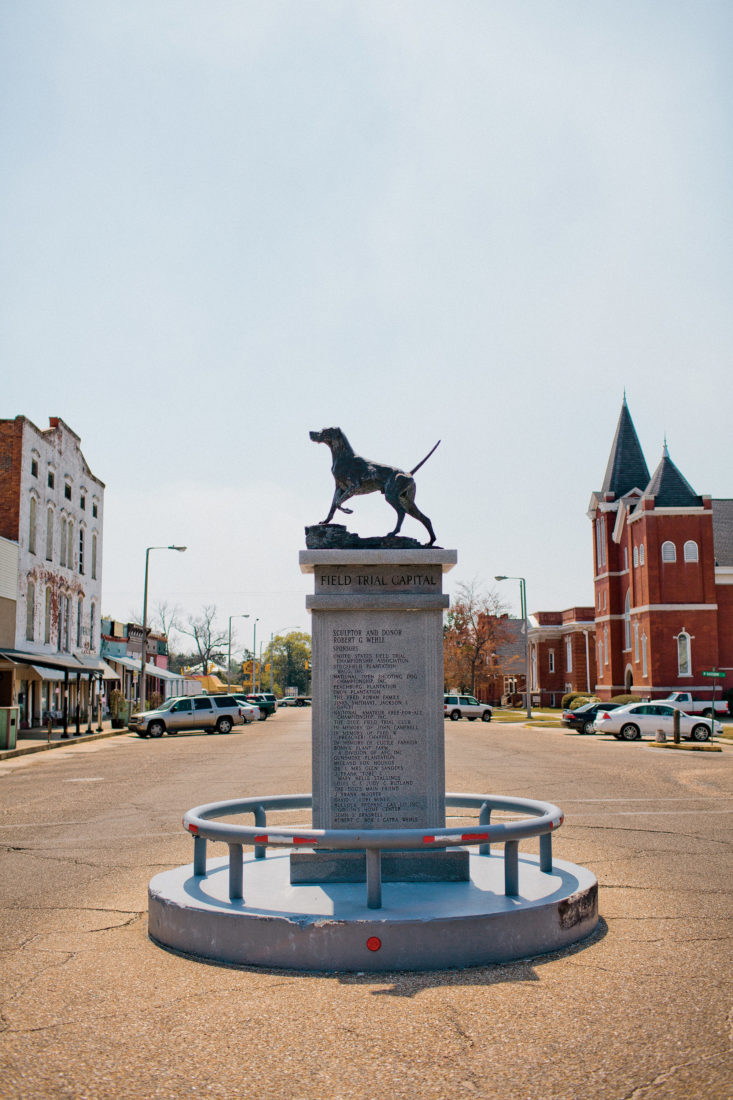
Photo: Caleb Chancey
The turnoff was five miles from Union Springs, a name that doesn’t mean much unless you care about bird dogs. In that case it means a lot. Resonates, I suppose, the same way the name Bordeaux does for people who care hopelessly about wine. Union Springs, which is about forty-five miles east of Montgomery in the Alabama Black Belt, is known as the field trial capital of the world. A bronze statue in the town square depicts not the usual Confederate infantryman but an English pointer, standing staunchly with head high and tail straight.
My wife and I came here to drop off my dog, an almost-two-year-old English setter, to be trained, and I worried that neither my dog nor I belonged here. As if we were…unworthy. Sending your dog for training in Union Springs is like sending your musical prodigy to Juilliard. But training him myself wouldn’t work. It hadn’t with any of my previous bird dogs and not for lack of trying. Bird dogs can be just as addictive as heroin and are slightly less expensive. There was a bookshelf in my office taken up with volumes on how to train your pointing dog, a lot of them with pages turned down and passages highlighted. The only real lesson I had learned, after much study, was that I am no dog trainer. Whatever the talent, I lack it utterly.
I had never met the man who would be training my dog. I had asked someone who knew the territory to recommend a trainer. Told him what I had in mind, and he said he would ask around and get back to me.
He called the next day and said, “I believe I’ve found the man you’re looking for. This fellow used to do a lot in the field trials. Had a good record, too. But he’s not doing that any longer. Nowadays he has a small kennel. Only four or five dogs. He works with them himself. No assistants. And he gets very good results. Two or three people I talked to have put their dogs with him and they swear by him.”
“That sounds perfect,” I said.
“Good. Let me give you his name and number. It’s Ramin Jackson.” He spelled out R-A-M-I-N.

Photo: Caleb Chancey
Jackson keeps an eye on his pupil.
I called Jackson, told him how I’d found him, hoping my friend’s name might buy me some credit, and said I’d like to talk about some dog training if he had the time.
“That would be fine,” he said. “It’s almost time for lunch. Tell me about this dog. What did you say his name is?”
“Woodrow,” I said.
“That’s good,” Jackson said, without explaining why.
“He’s a setter. And sort of a soft dog.”
“Yes. Most of them are.”
“But very game. From a real good breeder.” I was selling hard.
“Around here?”
“Montana,” I said, hoping that wouldn’t disqualify Woodrow in Jackson’s eyes.
“There’s some good ones out there.”
We talked for twenty or thirty minutes, and he asked what, exactly, I hoped for with Woodrow. Steady to wing and shot? Retrieve downed birds? Back another dog’s point? Was I ready for the possibility that no amount of training would make him into a bird dog?
Yes, I said.
“Well,” Jackson said, “then I’m looking forward to meeting Woodrow.”
Not me. Woodrow. I liked that.
Now the day had come, and I was at Jackson’s place to meet him and leave Woodrow to his care and training. Jackson was cleaning out kennels when we pulled in and parked next to a small barn. He walked over to greet us. He had a brilliant, genuine smile, and his clothes seemed far too clean and well pressed for the work he was doing. With introductions out of the way, Jackson’s focus turned to Woodrow, who was by now out on the grass, moving carefully around the property as if he might want to buy it.“Fine-looking dog,” he said. “Holds his head real nice and high. I like the way he moves, too. Yessir. He is a fine-looking dog.” Said in a way to convey the old, old truth that looks ain’t everything. And sometimes they ain’t nothing.
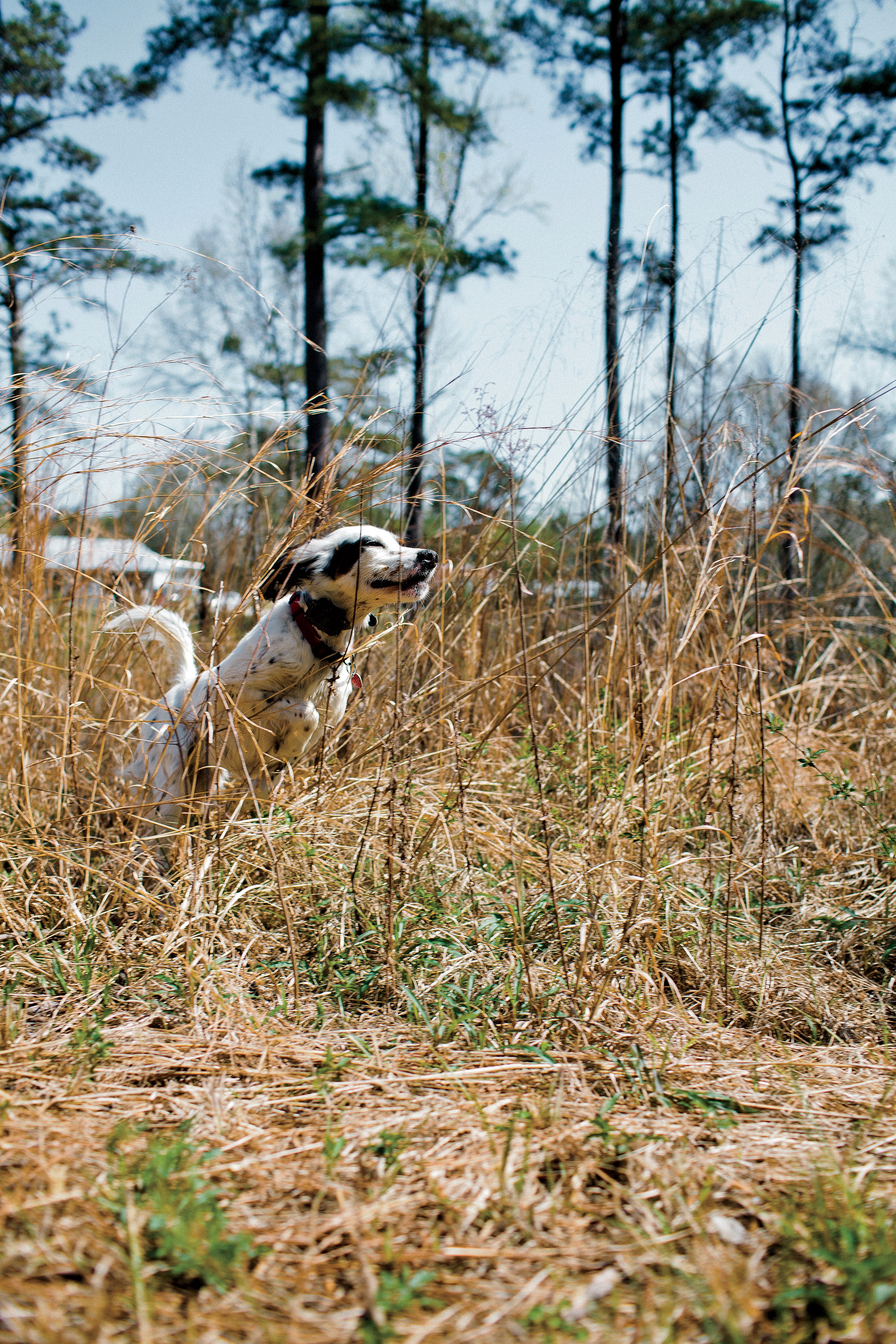
Photo: Caleb Chancey
Woodrow works the field for bird scent.
“’Course we won’t know about him until we get him on birds. You leave him here and give him some time to get used to me. Then call me and I’ll let you know how he is around birds.”
The first call was discouraging. “Woodrow doesn’t seem to care much about birds,” Jackson said. “But it’s still early. Let me try a couple of things. Call me again in a week or so.”
Well, I thought, if he won’t make a bird dog, he’ll still be a fine pet.
After another week, I called again.
“I am so proud of my man Woodrow,” Jackson said, his voice sounding especially musical. “And you’re going to be proud of him, too. Why don’t you come up and visit in another week or two? I’ll have him ready to put on a show for you.”
When I arrived, Woodrow was waiting on the grass outside his kennel, delighted to see me. So much so that I wondered if, in all the excitement, he might not remember what he’d been taught.
But Jackson got his mind back on business with one simple command. “Here, Woodrow,” he said, and that was enough. Woodrow stood by Jackson’s right heel looking more purposeful than I’d ever seen him. Like the boy who’d gone to boot camp and was now a man.
“I’ve got some birds put on that little hillside over there,” Jackson said. “Let’s go watch him work.”
Woodrow stayed at heel until Jackson released him, saying, “Hunt birds.” Woodrow tested the wind and went to work. It was, for me, a joy to behold. For Jackson, probably, just another day at the office.
Woodrow coursed the broom sage on the hillside and caught scent. He tensed.
“Careful,” Jackson said. Woodrow took another couple of steps and locked up.
“Look how nice he holds his head,” Jackson said. “Pretty, isn’t it?”
“Beautiful.” We walked in. Woodrow did not move. Not when we moved past him and not when the bobwhite got up in a blur and flew off at an angle and not when Jackson dropped the bird with the little 20-gauge he was carrying. Not until Jackson touched him and said, “Hunt birds.”
Woodrow went out to the dead bird, mouthed it, then dropped it. “He’ll pick ’em up, but he won’t retrieve them. Not yet.”
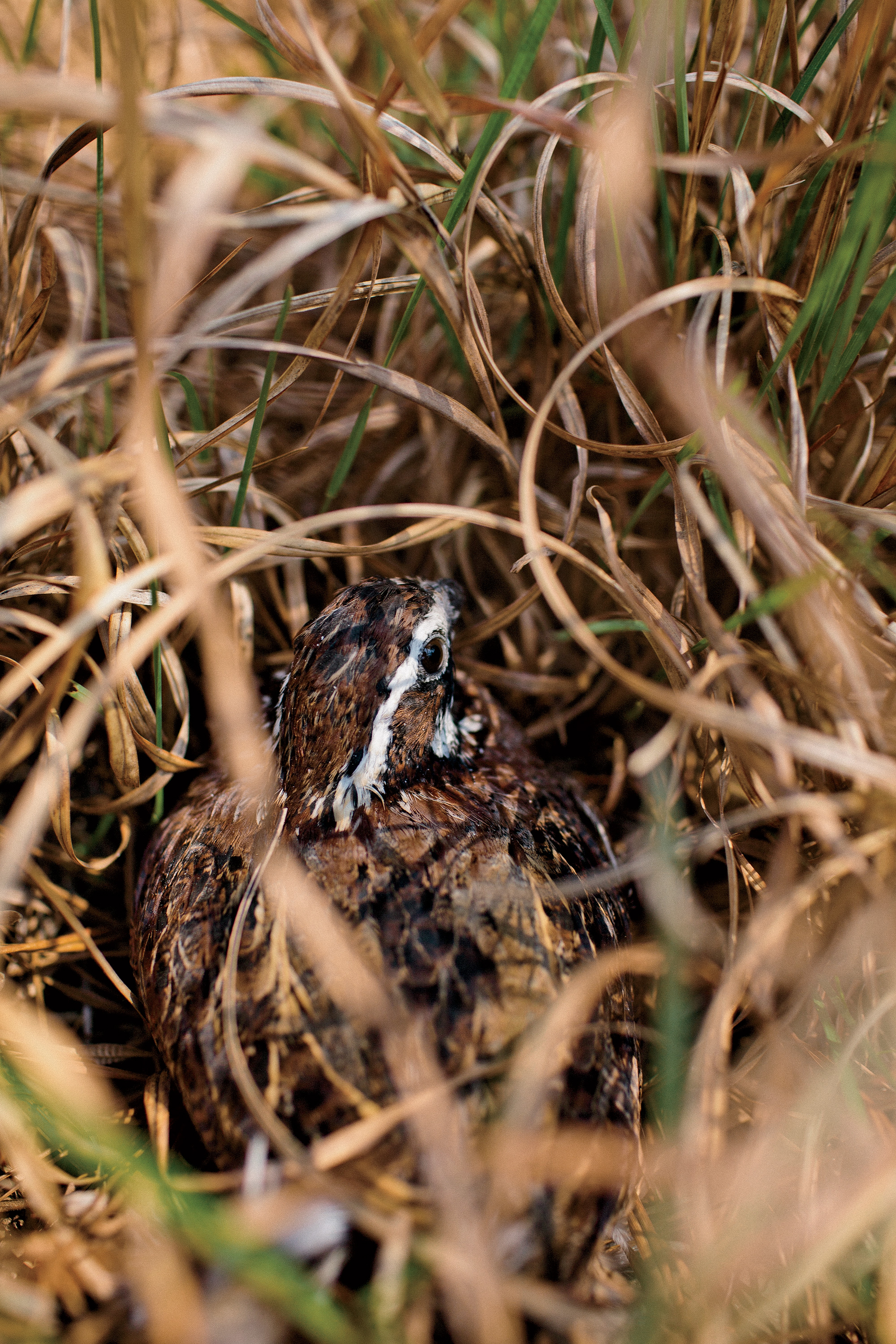
Photo: Caleb Chancey
A quail in the tall grass.
Woodrow worked another four or five birds. One of them hit the ground running after Jackson shot. The dog broke and ran for the wounded bird.
“Woodrow,” Jackson said, calm but firm. He came back, and Jackson positioned him as he had been before the shot. “Whoa,” Jackson said. That was it. No shouting. No hitting. No electricity from a shock collar. Just a firm tone of voice.
Woodrow did not move again until Jackson said, “Hunt birds,” and slapped him affectionately on the flank. Then he was back to working the wind for the scent of game.
Jackson had worked miracles. “How did you learn how to do this?” I asked. The way you might ask an artist how he’d “learned to paint.”
“Oh, I’ve always done it,” he said. “Ever since I was a kid growing up around here. My father did a little farming and we always had a couple of dogs we’d take out walk shooting.”
And was there anything that his father had told him that was the key? The secret? The thing that made everything else possible?
“He always said, ‘Don’t be too hard on ’em. Show a dog some love and make him trust you and then he’ll work for you.’ I’ve seen him get down with a dog and give him a kiss. Some people think you have to always use force. They’ll get on the dog with a shock collar until they’ve turned him into a blinker. The dog can smell birds and when he does, he just goes on around them. I’ve seen dogs run away from birds to keep from getting shocked.
“When I get a dog like that, I start out not doing anything. Just let the dog be a puppy again, play with the dog until he gets to trusting me, and work him up slow. You have to get to know a dog, first, before you can train him.”
“How do you get to know him?”
“Oh, there’s ways. I like to watch a dog for a while. I want to see if he’s got a nose for birds. I want to see how he moves. I want to know he can hear me when I’m talking to him. I’ll let him get used to me before I put my hands on him. Then I can move my hands along his backbone and see if he’s tense. Some dogs are soft and nervous, you know, like Woodrow. I’ll go slow with them so they get used to me.”
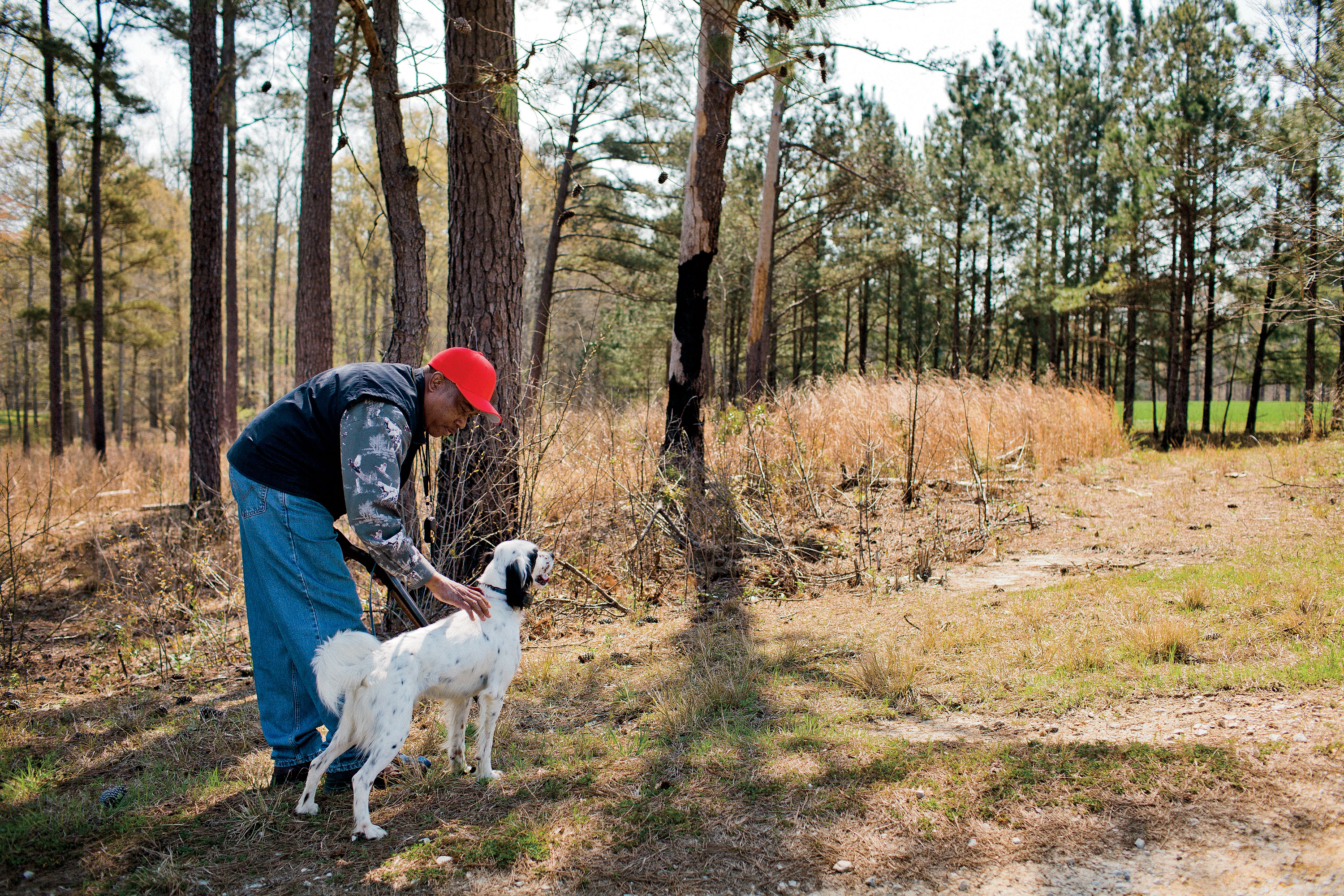
Photo: Caleb Chancey
Jackson works slow and steady with Woodrow, a trademark of his approach to training quality bird dogs.
One method he’d used with Woodrow, Jackson said, was to stand him on an empty fifty-five-gallon drum with birds in front of him, or tethered and flying around him, to teach him to be steady on point. If he moved, the barrel would roll and he would fall off. Jackson had used a check cord, mostly, and a shock collar, occasionally, to keep him in range and to remind him to stop cold on the command “Whoa.” He had put him in the field with another dog, and when she pointed had put Woodrow, who was on a leash at heel, on point to show him how to back. And so on. No magic tricks. Just standard training techniques. Easy to describe and very hard to execute.
“You ran dogs in field trials?” I said.
Yes, he said; that was after the one time in his life he’d been away from Bullock County.When he graduated from high school in the late seventies, he left for Michigan and a job in an automobile factory. But he came home after a couple of years. “I missed this place.
And I really missed working with the dogs.”
He worked on one of the big hunting plantations around Union Springs in the nineties, breaking horses and handling dogs. Guests who came to shoot at the plantation saw what kind of work he did and asked him to handle their dogs in some of the trials. So for several years in the nineties, Jackson trained champions. He took a runner-up in the Alabama Open with a dog named Native Shadow Mike and was twenty-third in a nationwide ranking of handlers. It was a challenge, he says, but he doesn’t miss it. Now he manages some property for an out-of-state owner and works a few dogs in his own kennel. “Only four or five,” he says. “That way I get to know those dogs. They’re all different, and it’s better when you can get to know them and take your time with them. Like with me and old Woodrow, here.”
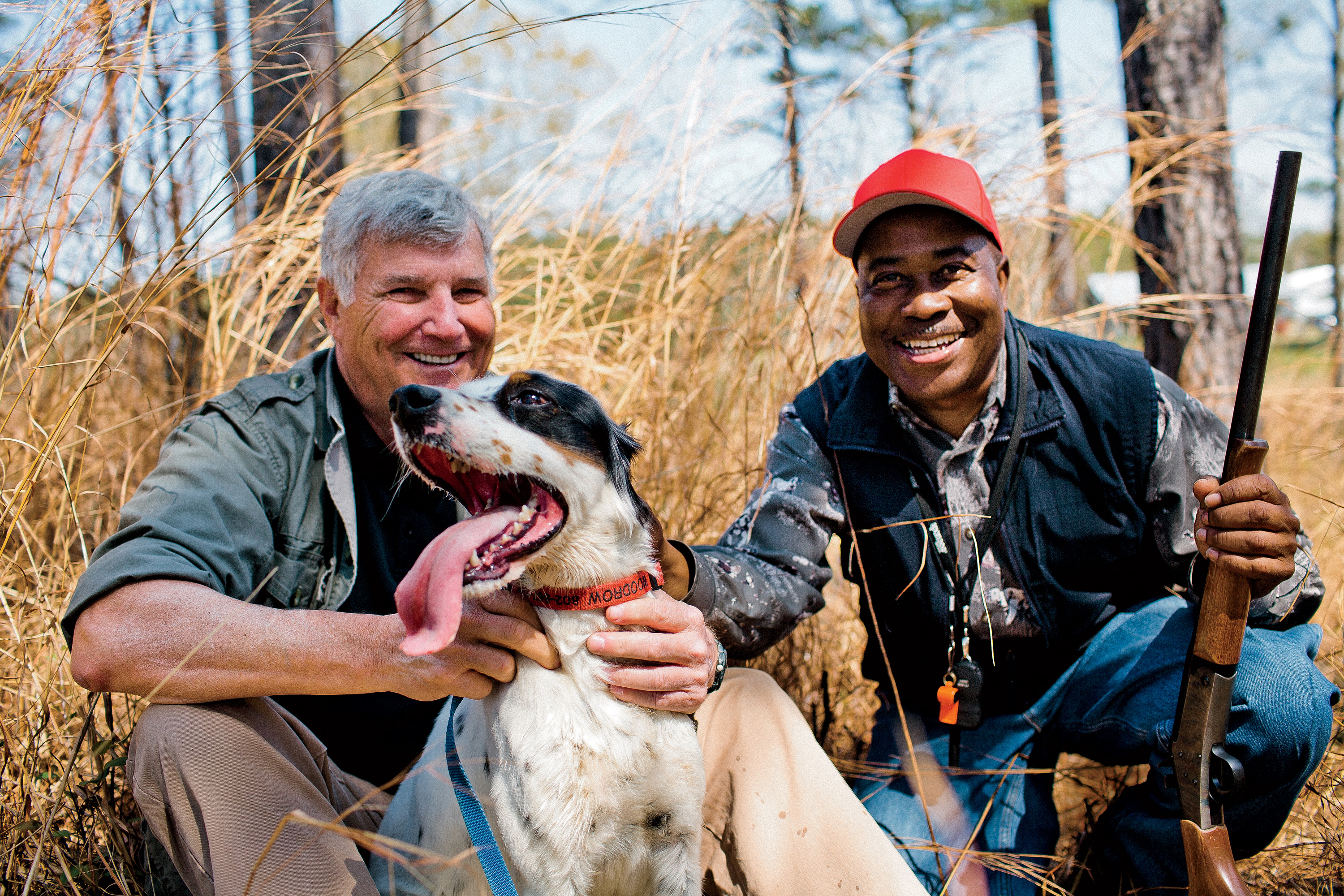
Photo: Caleb Chancey
The author (left), his English setter, Woodrow, and Ramin Jackson take a quick break from training.
As we talked some more, all my questions essentially came down to this: What’s the secret? “The most important thing with dogs,” Jackson said, “is patience. A lot of people, they’re in a hurry with the dog and they get mad when he makes a mistake and they’ll come down hard on him. They can’t help it. They don’t have that patience. But it makes the dog tense and then he makes another mistake and…you see how that goes.
“You need to keep working to get the dog to trust you, like I did with Woodrow. He was nervous when you left him. Didn’t know what to make of me. Wasn’t interested in birds. So I just let him run and, after a while, he’d come close and let me put my hands on him. Then he’d start to relax a little and I could work with him. I put him on the barrel with no birds around him, at first, just so he’d get used to being still and steady. Takes time. Woodrow is going to be a real good bird dog, now, for you. Real good.”
He was, plainly, proud of his work.
“He’s a real fine dog. I’m going to miss old Woodrow.”
“In that case, I’ll bring him back for a refresher.”
“You know,” Ramin Jackson said, “I was hoping you’d say that.”







